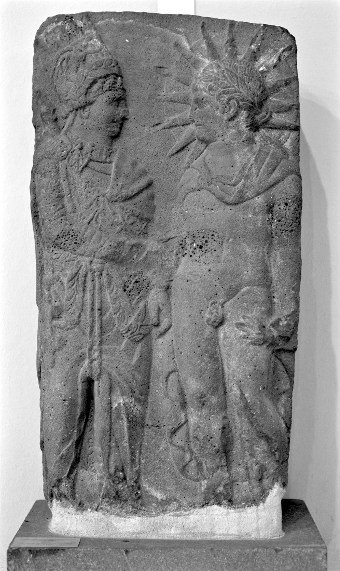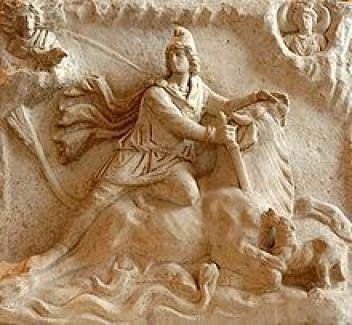The Menorah and the pine tree.
The Menorah and the pine tree.
Mark A. Flynn / December 13, 2020
I consider the festival of Hanukkah (also known as the Festival of Lights and the Feast of Dedication) and the Menorah to be an excellent, meaningful and specific replacement to the Christmas tree.

According to the 2003 Encyclopædia Britannica,
“The modern Christmas tree … originated in western Germany. The main prop of a popular medieval play about Adam and Eve was a fir tree hung with apples (paradise tree) representing the Garden of Eden. The Germans set up a paradise tree in their homes on December 24, the religious feast day of Adam and Eve. They hung wafers on it (symbolizing the host, the Christian sign of redemption); in a later tradition, the wafers were replaced by cookies of various shapes. Candles, too, were often added as the symbol of Christ. In the same room, during the Christmas season, was the Christmas pyramid, a triangular construction of wood, with shelves to hold Christmas figurines, decorated with evergreens, candles, and a star. By the 16th century, the Christmas pyramid and paradise tree had merged, becoming the Christmas tree.”
Modern Christmas trees have been said to have originated during the Renaissance of early modern Germany. Its 16th-century origins are sometimes associated with Martin Luther who is said to have first added candles to an evergreen tree.
In the 1850s, Franklin Pierce was the first to have a Christmas tree in the White House, and it was Calvin Coolidge who started the National Christmas Tree Lighting Ceremony on the White House lawn in 1923.
The Phrygians and later the Romans worshiped the “sacred pine” thousands of years earlier. This practice came about through the veneration of the ancient Anatolian goddess known as Cybele and her son Attis.
Cybele was originally known as the male god, Agdistis. The primordial gods emasculated Agdistis, transforming him into the “female’ goddess Cybele. An almond from a tree spawned from Agdistis’ (now Cybele) bloody gore resulted in the birth of his/her son Attis. Like Zeus, Attis was later abandoned and raised by the “he-goat” or Pan.
Parsing the subtleties of the story, Attis’ mother was also his father but at the same time he had no actual mother, since the mother was actually the father. Attis is a “widow’s” son, since the father had been lost, forever transformed. Looking at it in still another way, Attis was both father and mother of himself – since he came from and retained half the immortal power of Agdistis along with the mortal limitation of the almond tree grown from the earth.
As Attis was preparing to marry the daughter of King Midas, Cybele in a jealous rage appeared driving everyone at the wedding feast mad, causing an orgy of bloody self-destruction where Attis followed the fate of his father turned “mother”. Unlike his mother, the half-mortal Attis “died” from loss of blood.
Cybele repented of her jealousy and implored Zeus to save him, and so Zeus changed Attis into the “ever enduring” pine-tree which (at least) allowed hope for the possibility of later resurrection.
The Romans adopted the worship of the Phrygian “Mother of the Gods” in 204 B.C. towards the close of their long struggle with Hannibal. A prophecy from the Sibylline Books stated that a foreign invader would be driven from their land if the great Anatolian goddess was taken to Rome. Accordingly, ambassadors were dispatched to her sacred city, Pessinus in Phrygia. The mighty divinity was embodied as small black stone meteorite. It was conveyed to Rome, where it was received with great respect and installed in the temple of Victory on Palatine Hill. Soon after Cybele’s installation, the harvest was such as had not been seen for many years, and soon Hannibal’s occupying army left in defeat.
Sir James George Frazer (1854 – 1941), known for his comprehensive research in mythology, wrote “The Golden Bough: A Study in Magic and Religion”, where he described the activities of the Roman cult of Cybele and Attis:
A further step was taken by the Emperor Claudius when he incorporated
the Phrygian worship of the sacred tree, and with it probably the
orgiastic rites of Attis, in the established religion of Rome.
The great spring festival of Cybele and Attis is best known to us
in the form in which it was celebrated at Rome; but as we are informed
that the Roman ceremonies were also Phrygian, we may assume that they
differed hardly, if at all, from their Asiatic original. The order of
the festival seems to have been as follows.On the twenty-second day of March, a pine-tree was cut in the woods and
brought into the sanctuary of Cybele, where it was treated as a great
divinity. The duty of carrying the sacred tree was entrusted to a guild of
Tree-bearers. The trunk was swathed like a corpse with woollen bands and
decked with wreaths of violets, for violets were said to have sprung from
the blood of Attis, as roses and anemones from the blood of Adonis; and
the effigy of a young man, doubtless Attis himself, was tied to the middle
of the stem.
The March 22nd festival was known as Arbor Intrat. (The Tree Entered)
Just as the meaning of the tree inside the Temple of Cybele was accentuated by attaching a puppet-like effigy of Attis, modern Christmas trees sometimes include an elf, complete with red Phrygian cap. Attis, (who later was equated with the god Mithra) is the sleeping god, and like Prometheus, was punished for giving men the fire or light of knowledge.
March 23rd . The day of mourning, also the day of the Tubilustrium, accompanied by the blowing of trumpets. The Greeks called the day, Descensus. (“The Descent”)
March 24th. Sanguis (“The Day of Blood”)
Fraser describes the Sanguis in The Golden Bough:
Stirred by the wild barbaric music of clashing cymbals, rumbling drums, droning horns,
and screaming flutes, the inferior clergy whirled about in the dance with waggling heads
and streaming hair, until, rapt into a frenzy of excitement and insensible to pain,
they gashed their bodies with potsherds or slashed them with knives in order to bespatter
the altar and the sacred tree with their flowing blood. The ghastly rite probably formed
part of the mourning for Attis and may have been intended to strengthen him for
the resurrection…. Further, we may conjecture, though we are not expressly told,
that it was on the same Day of Blood and for the same purpose that the novices
sacrificed their virility. Wrought up to the highest pitch of religious excitement
they dashed the severed portions of themselves against the image of the cruel goddess.
These broken instruments of fertility were afterwards reverently wrapt up and buried
in the earth or in subterranean chambers sacred to Cybele, where, like the offering of blood,
they may have been deemed instrumental in recalling Attis to life and hastening the
general resurrection of nature, which was then bursting into leaf and blossom in the
vernal sunshine. Some confirmation of this conjecture is furnished by the savage
story that the mother of Attis conceived by putting in her bosom a pomegranate sprung
from the severed genitals of a man-monster named Agdestis, a sort of double of Attis.
Fraser continues:
While the flutes played, the drums beat, and the eunuch priests slashed
themselves with knives, the religious excitement gradually spread like a
wave among the crowd of onlookers, and many a one did that which he little
thought to do when he came as a holiday spectator to the festival.
For man after man, his veins throbbing with the music, his eyes fascinated
by the sight of the streaming blood, flung his garments from him,
leaped forth with a shout, and seizing one of the swords which stood
ready for the purpose, castrated himself on the spot. Then he ran through the city,
holding the bloody pieces in his hand, till he threw them into one of the houses
which he passed in his mad career. The household thus honored had to furnish
him with a suit of female attire and female ornaments, which he wore for the
rest of his life…. Indeed the story that Attis unmanned himself under a pine-tree
was clearly devised to explain why his priests did the same beside the sacred
violet-wreathed tree at his festival. At all events, we can hardly doubt that
the Day of Blood witnessed the mourning for Attis over an effigy of him which
was afterwards buried.
March 25th. Hilaria (“The Day of Joy”) or Hilaria Matris Deûm. (“Joy of the divine mother”) The Greek called the Ascensus. (“the ascent”)
Fraser describes the Hilaria:
But when night had fallen, the sorrow of the worshippers was turned to joy.
For suddenly a light shone in the darkness: the tomb was opened: the god had risen
from the dead; and as the priest touched the lips of the weeping mourners with balm,
he softly whispered in their ears the glad tidings of salvation.
The resurrection of the god was hailed by his disciples as a promise that
they too would issue triumphant from the corruption of the grave. On the morrow,
the twenty-fifth day of March, which was reckoned the vernal equinox, the divine
resurrection was celebrated with a wild outburst of glee. At Rome, and probably
elsewhere, the celebration took the form of a carnival. It was the Festival of Joy (Hilaria).
A universal license prevailed. Every man might say and do what he pleased.
People went about the streets in disguise. No dignity was too high or too sacred for
the humblest citizen to assume with impunity. All kinds of games and amusements were
allowed on this day; masquerades were the most prominent among them, and everyone might,
in his disguise, imitate whomsoever he liked, and even magistrates. The day of its
celebration was the first after the vernal equinox, or the first day of the year
which was longer than the night.
During this time initiates partook in a peculiar ritual of bull blood baptism.
Described by Fraser:
In the baptism the devotee, crowned with gold and wreathed with fillets,
descended into a pit, the mouth of which was covered with a wooden grating.
A bull, adorned with garlands of flowers, its forehead glittering with gold leaf,
was then driven on to the grating and there stabbed to death with a consecrated spear.
Its hot reeking blood poured in torrents through the apertures, and was received with
devout eagerness by the worshipper on every part of his person and garments,
till he emerged from the pit, drenched, dripping, and scarlet from head to foot,
to receive the homage, nay the adoration, of his fellows as one who had been
born again to eternal life and had washed away his sins in the blood of the bull.
For some time afterwards the fiction of a new birth was kept up by dieting him
on milk like a new-born babe. The regeneration of the worshipper took place at
the same time as the regeneration of his god, namely at the vernal equinox.
At Rome the new birth and the remission of sins by the shedding of bull’s
blood appear to have been carried out above all at the sanctuary of the
Phrygian goddess on the Vatican Hill, at or near the spot where the great
basilica of St. Peter’s now stands; for many inscriptions relating to
the rites were found when the church was being enlarged in 1608 or 1609.
The Romans later made Attis a solar deity in the 2nd century A.D. where he became known as Sol Invictus, the “invincible sun.” Still later, Roman Cybele/Attis worship morphed into the enigmatic cult of Mithra.
Numerous archeological artifacts have contributed to the modern knowledge of Mithraism. Depictions of Mithra show him being born from the rock, slaughtering a bull, and sharing a banquet with the sun god known to the Romans as Sol Invictus. Worshipers of Mithra had a complex system of seven grades of initiation and ritual meals. Initiates called themselves syndexioi, those “united by the handshake.”
The Tauroctony (taurus “bull” and ktonos “murder”) is the most common act of Mithra depicted in art.
Mithra, with the power of the Cybele and Attis combined, slays the bull in the ritual defamation killing of the Bull-Zeus-God. Sol Invictus is Attis. Mithras always looks to him while murdering the bull. When the initiate comes to the essential understanding of the mystery, “killing his bull,” he receives the Phrygian red cap.
The time-line of the modern tradition of bringing a (Christmas) tree into the home started with the Roman holiday of Arbor Intrat for Cybele and Attis (which occurred at Vernal Equinox) and was retained as the cult progressed over 700 years.
It later became associated with the Roman winter solstice festival for the death and resurrection of Sol Invictus (formerly known as Attis).
Time-line from Cybele and Attis to The Cult Of Mithra and Sol Invictus.
The Mithra link to Hanukkah
In 167 BC Israel was invaded by a quintessential example of a ‘type’ of the Antichrist.
The Greek king of the Seleucid Empire from 175 – 164 BC known as Mithradates, “given by the god Mithra” later became Antiochus Epiphanes, “god manifest.” Antiochus Epiphanes desecrated the Jewish Temple by building an altar to Zeus and sacrificing pigs.
Raging like a wild animal, he set out from Egypt and took Jerusalem by storm.
He ordered his soldiers to cut down without mercy those whom they met and to
slay those who took refuge in their houses. There was a massacre of young and old,
a killing of women and children, a slaughter of virgins and infants.
In the space of three days, eighty thousand were lost, forty thousand meeting
a violent death, and the same number being sold into slavery … Not long after
this the king sent an Athenian senator to force the Jews to abandon the
customs of their ancestors and live no longer by the laws of God; also to
profane the temple in Jerusalem and dedicate it to Olympian Zeus, and that
on Mount Gerizim to Zeus the Hospitable, as the inhabitants of the place
requested…They also brought into the temple things that were forbidden,
so that the altar was covered with abominable offerings prohibited by the laws.
A man could not keep the sabbath or celebrate the traditional feasts,
nor even admit that he was a Jew. At the suggestion of the citizens of Ptolemais,
a decree was issued ordering the neighboring Greek cities to act in the same
way against the Jews: oblige them to partake of the sacrifices, and put to death
those who would not consent to adopt the customs of the Greeks. It was obvious,
therefore, that disaster impended. Thus, two women who were arrested for having
circumcised their children were publicly paraded about the city with their babies
hanging at their breasts and then thrown down from the top of the city wall.
Others, who had assembled in nearby caves to observe the sabbath in secret,
were betrayed to Philip and all burned to death.
2 Maccabees 5:11–14, 6:1–11
The Jewish priest known as Mattathias and his five sons Jochanan, Simeon, Eleazar, Jonathan, and Judah led a rebellion against Antiochus. By 165 BC the Jewish revolt against the Seleucid monarchy was successful and the Temple was liberated. At the time of re-dedication, there was only enough oil to keep the menorah lit for one day but miraculously, the oil lasted eight days – the time that it took to prepare a new fresh supply sealed by the Kohen Gadol or High Priest.
What does the Menorah of the Temple symbolize?
The Menorah was made of pure gold – both the gold and the oil were beaten.
And thou shalt command the children of Israel, that they bring thee pure oil olive beaten for the light, to cause the lamp to burn always.
Exo 27:20And thou shalt make a candlestick of pure gold: of beaten work shall the candlestick be made: his shaft, and his branches, his bowls, his knops, and his flowers, shall be of the same.
Exo 25:31Their knops and their branches shall be of the same: all it shall be one beaten work of pure gold.
Exo 25:36And he made the candlestick of pure gold: of beaten work made he the candlestick; his shaft, and his branch, his bowls, his knops, and his flowers, were of the same:
Exo 37:17Their knops and their branches were of the same: all of it was one beaten work of pure gold.
Exo 37:22And this work of the candlestick was of beaten gold, unto the shaft thereof, unto the flowers thereof, was beaten work: according unto the pattern which the LORD had shewed Moses, so he made the candlestick.
Num 8:4
Jesus is the Gold:
And it was at Jerusalem the feast of the dedication, and it was winter.
And Jesus walked in the temple in Solomon’s porch.
Then came the Jews round about him, and said unto him, How long dost thou make us to doubt? If thou be the Christ, tell us plainly.
Jesus answered them, I told you, and ye believed not: the works that I do in my Father’s name, they bear witness of me.
But ye believe not, because ye are not of my sheep, as I said unto you.
My sheep hear my voice, and I know them, and they follow me:
And I give unto them eternal life; and they shall never perish, neither shall any man pluck them out of my hand.
My Father, which gave them me, is greater than all; and no man is able to pluck them out of my Father’s hand.
I and my Father are one.
Jhn 10:22-30Jesus was beaten:
He is despised and rejected of men; a man of sorrows, and acquainted with grief: and we hid as it were our faces from him; he was despised, and we esteemed him not.
Surely he hath borne our griefs, and carried our sorrows: yet we did esteem him stricken, smitten of God, and afflicted.
But he was wounded for our transgressions, he was bruised for our iniquities: the chastisement of our peace was upon him; and with his stripes we are healed.
Isa 53:3-5Jesus is The Light:
Then spake Jesus again unto them, saying, I am the light of the world: he that followeth me shall not walk in darkness, but shall have the light of life.
Jhn 8:12“The Roman-Jewish historian Flavius Josephus states that three of the seven lamps were allowed to burn during the day also; however, according to one opinion in the Talmud (Rashi, Tractate Shabbat 22b), only the center lamp was left burning all day, into which as much oil was put as into the others. Although all the other lights were extinguished, that light continued burning oil, in spite of the fact that it had been kindled first. This miracle according to the Talmud (Tractate Menahot 86b) was taken as a sign that the Shechinah rested over Israel. It was called the ner hama’aravi (Western lamp) because of the direction of its wick. This lamp was also referred to as the ner Elohim (lamp of God), mentioned in I Samuel 3:3.
The miracle of the ner hama’aravi ended about 40 years before the destruction of the Temple (c. 30 CE) according to the Talmud (Tractate Yoma 39a), “Our Rabbis taught: During the last forty years before the destruction of the Temple (that is to say from around 30 CE) the lot [‘For the Lord’] did not come up in the right …hand; nor did the crimson-coloured strap become white; nor did the westernmost light shine”.Of course the light failed to burn on the Menorah after 40 years before the destruction of the Temple. Jesus had died and risen from the dead. God’s spirit wasn’t limited to the Temple of Jerusalem but could reside in men’s hearts.
Agdistis, Cybele, Attis, Sol Invictus, Mithra. These are all names of the same diabolical deity that has been profanely worshiped for 7000 years.
The Antichrist figure Antiochus – the one “given by the god Mithra” the “god” that desecrated God’s Temple was defeated, but men still thinking in the paradigm of the fallen world worried that the light would fail.It did not.



